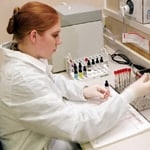Ron Hines DVM PhD
 See What Normal Blood & Urine Values Are
See What Normal Blood & Urine Values Are
 Causes Of Most Abnormal Blood & Urine Tests
Causes Of Most Abnormal Blood & Urine Tests

Your Dog Or Your Cat’s Respiratory Rate
Consider any major change in your pet’s respiratory rate – up or down – as a medical emergency when no obvious cause for it exists. Take appropriate emergency measures as you would for a human. Get in your car or taxi, rush to your nearest veterinarian. Keep a list of twenty-four hour emergency clinics taped to your refrigerator. Do your research before emergencies occur.
Just as your dog or cat’s body temperature and heart rate tell you a lot about its general health, your pet’s rate of breathing can alert you to potential serious health problems.
The rate at which our cats and dogs feel the urge to breathe is controlled by several centers (respiratory centers) in their brain, working together in complex ways. Resting breathing rates in cats are quite variable; but normal cats take less than 30-40 breaths per minute. Normal rates are equally variable in dogs.
Nerves (phrenic nerves) convey those messages to muscles in your pet’s diaphragm and between its ribs (intercostal muscles), establishing its respiratory rhythm. There are four of those brain centers deep within the head (in brain stem areas called the medulla oblongata and pons).
As your cat or dog breathes normally, only inhalation requires work, exhalation is just the springy response of its elastic chest (birds are the opposite – for them, exhalation takes effort). The four brain respiratory centers rely on chemoreceptors (cells that are sensitive to the C02 level in your pet’s blood) to establish the rate at which your pet breathes. (C02=carbon dioxide, measured as HCO3- or bicarbonate).
Additional input in setting your pet’s breathing rate comes from centers in its carotid arteries and aorta that measure the amount of oxygen as well as carbon dioxide in your dog or cat’s blood stream. (read here)
At any time, your dog and cat’s conscious brain can override the advice its respiratory centers are giving it – at least for a while (part of its unconscious autonomic nervous system).
Difficult respiration (dyspnea) is not necessarily rapid respiration. It is generally caused by lung or windpipe (tracheal) obstruction – although some of the things listed as causes of rapid respiration can be part of the underlying problem.
Strictly speaking, panting is not hyperventilation. It is the natural way dogs and cats cool their bodies because they do not sweat like we do (they do sweat between the bottoms of their paws). So if your dog or cat has been exercising heavily or exposed to hot temperatures, a faster respiratory rate with an open mouth (panting) is to be expected for a time.
You know your dog or cat best; any time that panting after exertion is greater than you expected and without obvious cause, you need to let your vet know. Those differences include: increased labor in obtaining sufficient air, breathing with an open mouth, increased belly and chest movement during each inspiration, louder than normal breathing sounds, wheezing, raspy or squeaky sounds, nostrils flared, elbows held wide apart, neck & head held low, They might, perhaps, be accompanied by mood, anxiety or interest and appetite changes. A change in tongue color to a more bluish hue is always a sign of concern.
Reasons Why Your Dog and Cat’s Respiratory Rate Might Be Higher Than It Should Be (= tachypnea, hyperventilation):
The most common reason your pet’s respirator rate might be elevated is its emotional state. Excitement, anxiety, fear, pain or even happy anticipation can all increase your pet’s respiratory rate (via the limbic system of its brain).
Overheating is probably the second most common cause. As I mentioned, dogs and cats are more subject to rapid breathing than we are when we are hot because their primary method of keeping their body temperature normal is through panting.
The third most common cause is an increased body temperature or fever underlying an increased respiratory rate.
Dehydration that accompanies heat stroke, fever, vomiting or gastrointestinal problems can also cause rapid respiration. Dehydration decrease your pet’s blood volume. That makes it more difficult for its blood to supply sufficient oxygen to its body.
Low blood oxygen (hypoxia) will also cause your dog or cat to breathe more rapidly. The two most common causes of low blood oxygen are heart failure and anemia. The most common causes of heart failure are heart valve failure in older pets and heartworms (usually in younger dogs). But any mechanical or biological reason for a pet’s heart to work less efficiently will cause the same problem. Heart problems such as hypertrophic cardiomyopathy (HCM) in cats, are another common cause of rapid breathing.
In cats, anemia due to Feline leukemia (FLV), feline AIDS (FIV) and FIP are common causes. In both cats and dogs, sudden heart failure occasionally does occur (cardiomyopathy). One of its signs is rapid respiration.
Another cause of anemia is autoimmune hemolytic anemia (primarily occurring in dogs).
Any other causes I listed for low PCV and low hemoglobin in your cat or dog can also be responsible for its rapid breathing. Asthma and heartworms in cats can also be the cause of rapid, difficult breathing.
Any form of pathology in your pet’s chest cavity that prevents normal oxygen movement into the pet’s blood will also lower blood oxygen and influence breathing rate. Those could be things like fluid or loose air in the chest, lung infections, tumors or restrictions to airflow during inspiration or expiration.
If a pet’s tummy (abdomen) swells sufficiently, its contents will press on the pet’s diaphragm and through doing that, restrict its ability to breathe. So, things like greatly enlarged livers, fluid leakage into the abdomen or a distended (enlarged) stomach will also cause the dog or cat to struggle to obtain enough oxygen. If your dog or cat’s diaphragm was torn in a car accident or fight, the pet might also hyperventilate and struggle to breathe (=dyspnea) for the same reason.
All the causes I listed for low blood pH (=metabolic acidosis) or low blood HCO3 can also cause your dog or cat to breathe faster. Problems like diabetes or kidney failure can lead to that.
Cats with an abnormally high metabolic rate due to hyperthyroidism might also breathe faster than normal.
Pregnant pets sometimes breath faster because of the extra oxygen needs of the babies within them. Puppies and kittens also have a slightly more rapid respiratory rate than adults.
Collapse of the circulatory system, as occurs in dogs and cats that are in shock due to car accidents, fights, sudden severe allergies or vaccine reactions (anaphylactic shock), advanced heart disease, etc. will also breathe rapidly – (These are medical emergencies that require the same lifesaving procedures: CPR, etc. perform on them as you rush to your veterinarian’s office).
All medications that are considered stimulants in human medicine can be responsible for increased respiratory rate of your dog or cat. Some of those stimulants, like caffeine, chocolate or ADHA medications, would most likely be eaten by accident. But others, like phenylpropanolamine (Proin), are given to control bladder leakage in older female dogs (and occasionally in cats). Too high a dose of thyroid medications (levothyroxine) will also cause an increase in your pet’s respiratory rate.
Reasons Why Your Pet’s Respiratory Rate Could Be Slower Than It Should Be (=hypoventilation):
There are considerably fewer reasons your dog or cat would breathe slower than normal than there are for rapid respiration.
They would of course if they were asleep. But very rare brain diseases, affecting the pet’s respiratory centers could also be responsible. I know of none that would not also cause many other more serious warning signs that your pet was seriously ill.
More commonly, an overdose of a sedative medication – either one prescribed for your pet or for a human family member – and accidentally eaten by your dog or cat will cause over-sedation, coma and eventually even respiratory failure – just as it would in humans. Overdoses of alcohol could do the same. In a veterinary hospital setting, amounts of general anesthetic gas, narcotics, tranquilizers or sedatives that are inappropriately large for your pet’s condition or body weight can also slowly lead to total failure of its respiratory centers if not promptly tended to.
All causes of metabolic alkalosis (higher than normal blood pH levels), including serious vomiting, starvation, bicarbonate overdoses or overdoses of diuretics (e.g. furosemide/Lasix) can all decrease your pet’s respiratory rate. In all these cases, your dog or cat’s blood bicarbonate level would likely be high.
Prolonged exposure to severe cold (hypothermia) also depresses your cat or dog’s respiratory centers and rate of breathing.
Complementary Tests:
CBC / WBC and blood chemistry values including blood bicarbonate or CO2 levels, Anion gap, thoracic (chest) ultrasound and x-rays. Further tests chosen by your veterinarian based on the results of those initial ones.
DxMe



